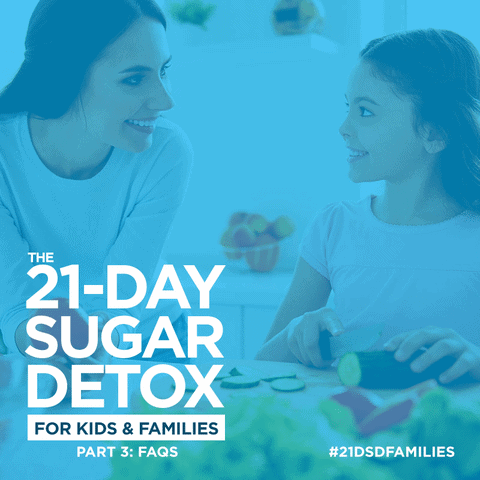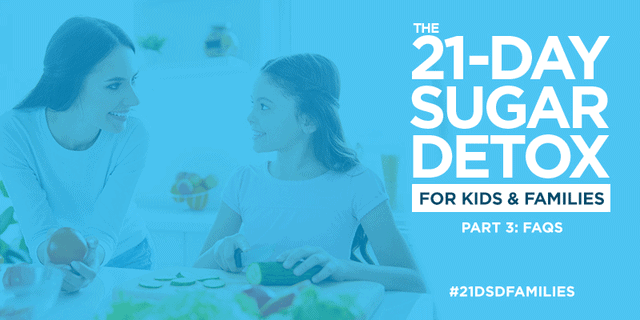Lots of parents are concerned about their children’s dependence on grain -based and sugar- laden foods. But what can parents do to help their children eat a more nutrient-dense, quality diet? Look no further! And if you have already decided that the 21-Day Sugar Detox is a good fit for your family, here are some questions that other Sugar Slayers have asked that you might find useful.
Q: How do I make the transition to a 21DSD for kids (especially younger ones ages 5-12)? How do I transition them without them feeling different from their friends?
A: Every family is different, and if you have not already transitioned your kids to a Paleo diet, the transition to a 21DSD eating plan will probably be much more difficult. For my family, it was a very gradual process during which I removed an undesirable item (like wheat flour) from the house and introduced new items (like coconut oil). Some families benefit from a “cold turkey” approach in which they clean out their pantries and fridges and only stock them with Paleo-friendly foods. Either approach would work for transitioning your kids to a 21DSD as well. However, the most successful transition will take place when all of the adults in the home are on the same page. And remember that kids might, or might not resist, but they will eventually adjust, especially if you provide lots of tasty meals and snacks.
Regarding how to help your kids not feel different from other kids, especially at school, the key is to ask your kids what foods they would like included in their lunches and allow them some leeway through the transition process to include foods that might not be the best nutritional choices, but might be better than previous foods and more acceptable to non-Paleo friends. For example, if your kids have sandwiches every day for lunch, try making some nut-flour bread instead of buying whole grain wheat bread from the store. Or, if they are not big on vegetables, reserve those for family dinners and pack fruit for lunch.

As your kids become more accustomed to this new way of eating, their tastes will likely change and they will be more open to different choices than they were before. When my older daughter asks why we don’t buy/make something that we used to, I tell her that there are better choices and we want to eat the best food we can to be healthy and strong. I don’t restrict her away-from-home foods, and that is a concession that my husband and I make, but that you might not feel comfortable with. We feel that as kids get older, we need to let them make some decisions for themselves while they are away from home as long as they don’t have diagnosed food sensitivities, food allergies, or other medical conditions that make it unsafe for them to consume particular foods. The bottom line is that you will need to figure out what is “acceptable” to you and what is not. And it’s okay for that line to change over time as your kids grow and as you learn more about real food and how it affects all of you individually.
If you are concerned that they will be missing out if you don’t allow them to eat marshmallows while camping or you keep them from ordering hamburgers with the bun, remember that you are the parent and as long as you are the decision-maker, you will need to pick those battles that are most important to you. You are not a bad parent if you decide to let them have the occasional sugary treat; likewise, you are not a bad parent if you decide not to let them have it. My policy is to have balance and to allow “no” foods on occasion when the time is right. For us, that means we might have some ice cream, but not on the same day or even week as roti (a wheat-flour flatbread) at my in-laws’ house. We don’t keep either of those foods in the house, and when we have them, they are a treat.
Want an additional resource? Check out Matt and Stacy at Real Everything. Formerly the Paleo Parents, these two have good stories and tips about how to transition your children to a Paleo diet/lifestyle if that is something that you want to pursue. Their transition tips are easily applicable to a transition to 21DSD eating.
Q: Full-fat vs. low-fat dairy recommendations from pediatricians?
A: Pediatricians recommend switching from full-fat dairy to low-fat dairy when children turn two because of the widely-held belief that consuming foods that are high in fat (especially saturated fat) will result in excess weight gain. We know, however, that those fats are good for growing children’s brains, good for keeping us all satisfied, and good for stabilizing blood sugar. My kids have always consumed whole milk and full-fat dairy, and they are definitely not overweight. Stick to the less processed versions of dairy and limit the amounts you provide for your kids if you are concerned about weight issues; there are plenty of other ways to get healthy fats and protein without dairy.
Q: What about whole grain snacks? Alternatives?
A: If you are coming from a Standard American Diet and have been including grains as a regular part of your meals, you might be at a loss as to what to eat instead. There are lots of great snacks that you can use to replace whole grain snacks, which offer little nutrition and may cause digestive distress or behavioral problems, or worsen preexisting medical conditions. Some snacks my kids like: trail mix, Larabars (or any alternative that is made from real, whole ingredients without added sweeteners), toasted coconut flakes, jerky, gluten-free crackers with butter on them, raw vegetables, whole fruit, plain full-fat yogurt sprinkled with cinnamon, and roasted seaweed. You may need to experiment with what your kids will like. See the question about transitioning them to a sugar-free way of eating for more ideas.
Q: How do you explain it when your kids learn “nutrition” in school?
A: This is a tough one because you want to teach your kids what you believe is correct nutritional advice, but you don’t want to undermine the teacher’s authority. When my kids come home with nutrition information, I tell them when I disagree and I explain why (as simply as possible)…or sometimes I just nod and ignore it. I believe that you have to pick your battles, and if what they are taught at school is a minor deviation from what I believe is true, I might just let it go and keep feeding them as I see fit. I also frequently say that different people have different opinions about what “healthy” food is, but that I have done a lot of studying and I believe that I am giving them the best information I have available. At some point, they will figure things out on their own, and while I want them to question what they are told, I also want them to be able to explain why they are questioning it. As with all parenting decisions, this is one only you can make, but I believe that keeping communication open with your kids will help them move through all of the potentially difficult conversations they will have with both teachers and peers.
Q: What are some school snack ideas that are nonperishable?
A: Jerky, seaweed snacks, nuts and seeds, nut butter, coconut flakes, gluten-free crackers, kale chips, grain-free and unsweetened granola. Not during a 21DSD: dried fruit, Larabars or other date-nut bars, unsweetened fruit/applesauce pouches.
Q: How do I get more healthy fats in my kids (especially if they don’t love coconut or avocado on their own); how can I keep them satiated through the day?
A: I struggle with this one a bit since one of my daughters doesn’t like meat very much and she doesn’t like many foods that have high fat content. I try to provide some type of healthy fat in every meal, especially at breakfast and dinner (the meals she always eats at home).
To make sure she gets some healthy fats in, here are some of my “tricks”:
- I use coconut milk in smoothies and some meals.
- I make nut flour breads or pancakes about once a week.
- I put butter on everything! Gluten-free crackers, rice, sweet potatoes, nut flour bread and pancakes, eggs, etc. Good thing she likes butter!
- I offer avocado every week or so; sometimes she’ll eat some, but sometimes not. Making it into guacamole often helps, too.
- I use chicken thighs instead of chicken breasts.
- I give her whole, raw milk and full-fat yogurt almost daily, as well as cheese on occasion.
- I cook eggs for breakfast about half of the days of the week.
- I offer some type of fish once or twice a week.
Ultimately, if your kids will eat a good amount of protein at each meal, they will stay satiated. Try to work in whatever fats you can, and don’t worry if they seem hungry all the time. They are growing and will definitely go through periods when they seem insatiable, and then at other times don’t seem to eat enough. Trust them to know their bodies and how much they need to feel full.
Q: What should I do if my kids can’t or won’t eat meat/eggs/nuts/coconut/dairy/etc.?
A: While I can’t make specific recommendations for every exclusion or substitution you might need to make, there are many resources out there to help you find alternatives. No one knows your child better than you, so you will need to filter recipes and ideas through your own child’s age, dietary needs/restrictions, and taste preferences.
Here are some general substitution recommendations:
No nuts? Try seeds (pumpkin seeds and sunflower seeds are usually the most kid-friendly). You can grind them for use in pancakes or baked goods, or you can make seed butter for dipping their green apples or celery sticks. They are also tasty as is.
No coconut? Bummer. Not only is coconut delicious, but it is also antibacterial, antimicrobial, and a great source of medium-chain fatty acids. However, if your kids can’t or won’t eat it, don’t worry too much. They will still be healthy even if they can’t tolerate coconut products. If your kids simply don’t like coconut, you can add some coconut milk or oil to smoothies, use the oil for cooking their eggs or other pan-cooked items, or mix finely shredded coconut into their Paleo banana bread or grain-free granola. They probably won’t even notice it!
No eggs? If you’d really like to keep some egg-based meals, consider using duck eggs (or another type of bird egg). One of my daughters is sensitive to chicken eggs, but can eat pancakes or baked goods with duck eggs without any problems. This allows everyone in our family to enjoy some of these foods on occasion so that she is not excluded. If you want/need to eliminate all eggs, focus on proteins, healthy fats, some fruit, and vegetables for all meals (including breakfast). Sausage, ham, and bacon are great kid-friendly breakfast meats. And remember that just because it isn’t appetizing to you, your kids may love it! Offer some sliced turkey or leftover meatloaf with a banana and see what happens!
No meat? I have one of those kids that just doesn’t like meat very much. She likes chicken more than beef or pork, and won’t even look at lamb unless it is ground. She does eat some seafood, though, and loves eggs, so I don’t worry about her protein consumption too much. Sometimes it takes some work to find out the types of meat that your kids will like, and even then it might be more of a texture or preparation issue than a flavor issue. For example, most kids like ground meat, so you might offer that once or twice a week and mix in some ground pork or lamb with your ground beef to get in some different flavors and nutrients. Do they like sauces? Find one that they enjoy and offer it with a protein they don’t like as much. Keep trying new things, and encourage your kids to try a bite of meat at every meal. Even if they won’t eat more than that bite, they may eventually come around and take a second or third bite without your prompting. Also, talk with your kids if they are old enough about what meat does for their bodies (it is needed to build and repair growing muscles, help the brain function properly, and fill you up with nutrient-dense food so that you don’t get hungry between meals). My daughter may not like meat very much, but she will sometimes eat some because she understands that it is good for her.
No sweet potatoes? Not all kids love sweet potatoes, but there are many sources of dense carbs. Check out this list and mix and match according to what your kids like/tolerate well. Don't worry about the total carb count–kids need a variety of starchy vegetables so they get enough carbohydrates as well as vitamins, minerals, and phytonutrients. It is okay for kids to eat more fruit in order to round out their nutrient consumption, but attempt or strive to focus on the vegetables.
 Rebekah Reddy is mom to her three children (two girls, one boy), content development support member of Team Diane, and a part-time high school English/ESL teacher. She holds a BA in English with a minor in Spanish, an MA in English with an emphasis in Teaching English to Speakers of Other Languages (TESOL), and a California teaching credential. She is also a certified Nutrition Educator, 21DSD Certified Coach, and the author of the blog Half Indian Cook through which she shares recipes and writes about food and culture in her mixed-ethnicity family. Rebekah’s passion for delicious, nutritious food has led her entire family to improved health and happiness!
Rebekah Reddy is mom to her three children (two girls, one boy), content development support member of Team Diane, and a part-time high school English/ESL teacher. She holds a BA in English with a minor in Spanish, an MA in English with an emphasis in Teaching English to Speakers of Other Languages (TESOL), and a California teaching credential. She is also a certified Nutrition Educator, 21DSD Certified Coach, and the author of the blog Half Indian Cook through which she shares recipes and writes about food and culture in her mixed-ethnicity family. Rebekah’s passion for delicious, nutritious food has led her entire family to improved health and happiness!


Comments 2
sorry for asking this silly question But i just want to make sure my son has a yeast issue and he has to go sugar free, does that mean he can have the snack in your 21 day sugar detox book?
like i said Just making sure.
Thank you !
Hi Madeline,
I would talk to your son’s doctor to make sure it fits his issues specifically, but yes all of the snacks in the 21DSD are sugar-free, so they should fit the parameters of what your son is needing. —Moriah, Team 21DSD